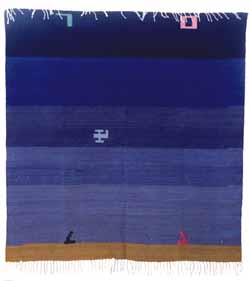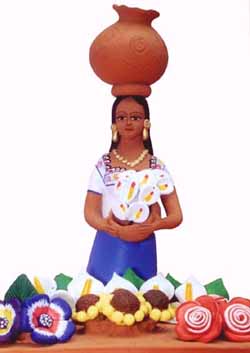Mexican Ways of Knowing
Hampshire, an artist of multiple media, is one of many young Oaxacan artists who are producing alternatives to that region's traditional folk art. He is also one of the artists participating in the upcoming weekend course, "Conversations Across Cultures: Mexican Ways of Knowing." From March 7th through 9th, artists, researchers, social activists and educators with expertise in Mexican art and culture, will open up conversations about historical, social, and political issues that have made an impact on Mexican cultural understanding, indigenous identity, and artistic practice.
An exhibition of Hampshire's and six other artists' work, as well as a selection of contemporary textile art from Mexico, will be on display in Macy Gallery from February 17th until March 9th. The conference itself, as a multisensory, multifaceted experience, will expand students' understanding of Mexico on many levels, and raise important questions about art, research and teaching.
Hampshire, who embraces the trappings of life in a media-saturated world, keeps coming back to Oaxaca's craft tradition, creating an historical-postmodern dialogue. He humorously places figures, such as Playmobile toys, Star Wars characters, and the Mexican wrestler El Santo, into paintings of iconic images from art history, or he inserts images from an Atari game into an otherwise culturally typical Oaxacan tapestry. "I am interested in memory as a starting point for the image, a metaphor between reality and fiction. Mine is a subversive exercise that questions the function of memory."
The other end of the spectrum of Mexican, and in this case, Oaxacan, art might be the work of two artisans from the pueblo, Ocotlán de Morelos, in Oaxaca. Sisters Guillermina and Irene Aguilar Alcántara will give a gallery talk on Friday, March 7th, in which they will explain techniques that were passed down to them and other siblings by their mother, Isaura Alcántara Diez, who was the first ceramicist in Ocotlán to make decorative human figures doing daily activities. Each of the sisters have pieces in the Museum of the American Indian's current exhibition, "Great Masters Of Mexican Folk Art." Guillermina makes female figures of all sizes, which she adorns with detailed and colorful Oaxacan dress. "A whole family working in clay is like a plant that eternally flowers," she says. Seeing the Aguilar Alcántara's work next to Hampshire's will open up many avenues for discussion of tradition and modernity in Mexico.
As one of the goals of the Conversations series is to bring indigenous knowledge and issues to the table, three participants will relate their experiences working in the state of Chiapas, which has been riddled by a war for indigenous rights, since the Zapatista Liberation Army revolted in 1994. To provide background for the discussion, the course will present the film, "The Sixth Sun: Mayan Uprising in Chiapas," by Saul Landau.
Art historians Wendy Schoenfeld and Tatiana Flores will speak about Pre-Columbian art and its relationship to current indigenous folk art, and Mexican art of the 1920s and 30s. Christina Veran, a journalist and historian, will relate her experiences documenting a broad range of artistic challenges to social and political crises in Mexico. Leslie Martino and Patricia Ayala, master's students at TC, will talk about historical and contemporary education issues in Mexico.
Through this diverse offering of events, this conference will give each student several new vantage points from which they can continue to explore Mexican ways of knowing. For more information, contact CEO&I at x3987.
Published Monday, Feb. 10, 2003

